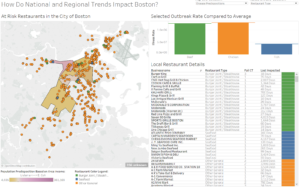Team Members: Theresa, Tanaya, Philip
Fueling Frenzy is an iteration of the Games Sketch: Fuel Frenzy data game, with a complete deck of cards and two sets of rules, so the deck can be used for a suite of multiplayer games that teach basic concepts of meal planning with balanced nutrition.
The data we used appears mostly in the cards’ attributes.
Data: Cards
We surveyed the free food available in the Sloan Slack to create the “Free food” deck, with card frequency based directly on the number of times each food was offered in the free food channel. The foods available in general deck were chosen after observing the food available on campus in dining halls, the student center, and an independent living group’s monthly menu. Foods that were observed more frequently (3+ times) appear twice in the deck, and foods that appear less frequently (1 or 2 times) appear once in the deck. Event cards were based on the MIT event calendar and food outbreak data.
The foods are divided into four categories: Protein, starch, fruits&veggies, and junk. The cards are ranked within their category based on what we judged as the category’s stereotypically-associated nutrient. Proteins were ranked by grams of protein, starches by grams of fiber, fruits&veggies by milligrams of vitamins, and junk by kilocalories. The nutrient data was found in the USDA food composition database. Most categories have foods ranked from 10 points to 2 points. Junk food is the only category with foods worth only 1 point, and with a maximum of only 5 points, after we agreed through discussion that some junk foods are substantial enough that it is unrealistic to rank them all as 1 point. However, junk foods still do not qualify for any bonus points, and thus simulate the fact that junk food is used only to meet immediate hunger/snackish-ness and not for nutritional gain.
The data as it’s applied to the cards is summarized in the Food Scores spreadsheet.
Story: Orientation, Freshman Year
The story is follows the ways that freshmen learn to be thoughtful when making food choices over the course of their first semester at MIT. The games are intended to be played in order during a session of orientation.
The session begins with the game of chance, followed by a discussion in the orientation group, followed by the strategy game. The random chance game simulates the mentality that freshmen often start with–just eat enough to be full, find food wherever it’s available–and then makes them reconsider whether this strategy is sustainable. Discussion questions asked by the orientation leader may include: What kinds of meals did you make? Is anything missing from, or over-abundant in, those meals? Would you eat like that in real life? Do you think the meals you created here provide enough fuel to a) go on a run? or b) ace a long test? How have you been eating during orientation?
The orientation leader would then explain the rules of the strategy game, which incorporates a more thoughtful approach to meal planning through a point-based card game. Through bonus points and nutrition goals, the game encourages players to think about balanced meals and the ways that different foods complement each other nutritionally.
A concrete, material takeaway of this orientation session is a booklet of simple recipes teaching freshmen how to cook staple foods like steamed broccoli, fish, and potatoes. While the orientation leader is passing this out, he or she could again have a short discussion and answer questions from the freshmen about food options on campus. Some of the prompts for this discussion might include: were you surprised by any of the nutritional values of the foods? Were the meals you made in the strategy game more like meals you’d eat in real life? What strategies were more successful in pairing foods to maximize nutrition? If you ran out of cards before the end of the game, how might you change your strategy in the future?
The combination of the simulation through game play and debrief discussion create an environment for thoughtful engagement with the challenges of eating healthy at MIT.
The presentation for our game, which includes rule sheets, can be found here.




